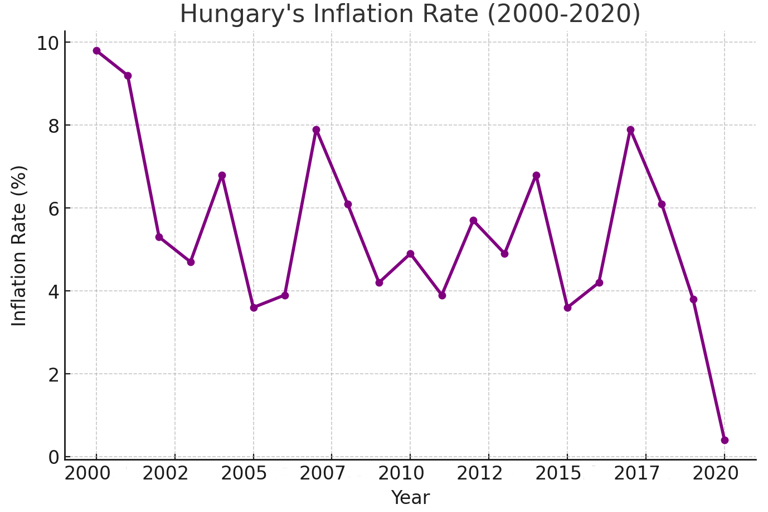Inflation Trends in Hungary: 2000-2020
Inflation Trends in Hungary: 2000-2020
1/19/20251 min read
Inflation is a key economic indicator that affects businesses, consumer purchasing power, and market stability. Over the past two decades, Hungary has experienced fluctuations in inflation rates, influenced by global economic trends, policy decisions, and market dynamics. Understanding these changes is crucial for businesses seeking to adapt their pricing strategies and financial planning.
Hungary’s Inflation Trends (2000-2020)
The inflation rate in Hungary has varied significantly over the years:
2000-2005: Inflation remained high, averaging around 9-10% due to economic transition and policy adjustments.
2006-2010: A period of economic tightening saw inflation decline, fluctuating between 3-7%.
2011-2015: Hungary experienced lower inflation, stabilizing around 0-3%, with some years of near deflation.
2016-2020: Inflation rose again, reaching 4-5% by 2020, driven by economic growth and rising consumer demand.
Factors Influencing Inflation in Hungary
Several factors have contributed to Hungary’s inflationary trends:
Government policies – Changes in taxation (e.g., VAT adjustments) and fiscal measures impacted price levels.
Global economic trends – Oil price fluctuations and financial crises influenced inflation rates.
Exchange rate movements – The Hungarian Forint (HUF) value affected import costs and consumer prices.
Wage growth – Rising wages led to increased consumer spending, affecting inflation.
Impact of Inflation on Businesses and Consumers
Inflation directly influences:
Consumer Purchasing Power: Higher inflation reduces disposable income and shifts consumer preferences.
Pricing Strategies: Businesses must adjust prices to maintain profit margins while staying competitive.
Investment Decisions: Inflation affects interest rates and financial planning for companies.
Visual Representation: Hungary’s Inflation Trends (2000-2020)
How Businesses Can Adapt to Inflation?
Monitor Market Trends: Stay updated on economic shifts to make informed pricing decisions.
Diversify Revenue Streams: Reducing reliance on single products/services helps manage financial risks.
Leverage Market Research: Understanding consumer behavior during inflationary periods helps optimize business strategies.
At Reakty, we provide in-depth market research and consumer insights to help businesses navigate economic challenges. Contact us for expert analysis tailored to Hungary’s evolving market conditions.
Stay tuned for more insights on Hungary’s economic landscape!


